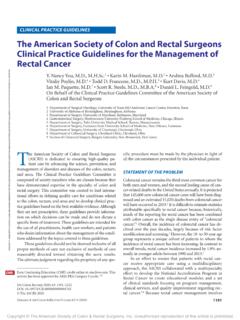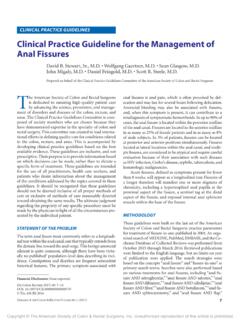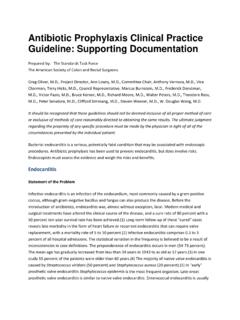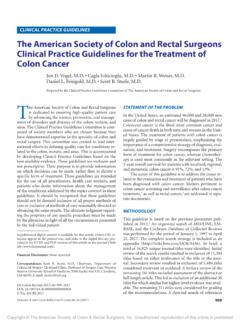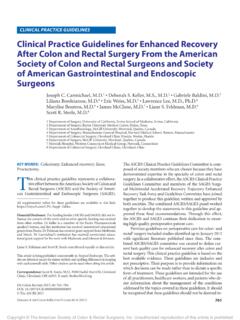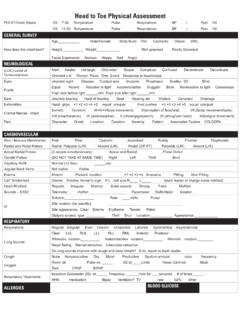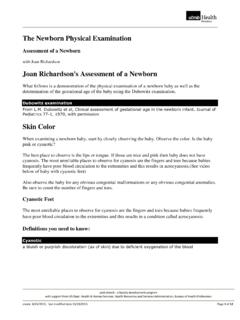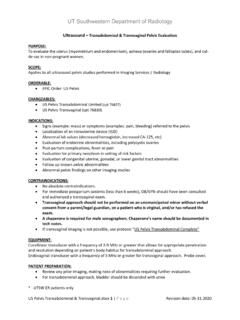Transcription of Clinical Practice Guideline for the Management of ...
1 Copyright The American Society of Colon & Rectal Surgeons, Inc. Unauthorized reproduction of this article is of the Colon & ReCtum Volume 59: 12 (2016) the american society of Colon and Rectal sur-geons is dedicated to ensuring high-quality pa-tient care by advancing the science, prevention, and Management of disorders and diseases of the co-lon, rectum, and anus. the Clinical Practice Guide-lines Committee is charged with leading international efforts in defining quality care for conditions related to the colon, rectum, and anus by developing Clinical Practice guidelines based on the best available evidence.
2 These guidelines are inclusive, not prescriptive, and are intended for the use of all practitioners, health care workers, and patients who desire information about the Management of the conditions addressed by the topics covered in these guidelines. their purpose is to provide information based on which decisions can be made, rather than dictate a specific form of should be recognized that these guidelines should not be deemed inclusive of all proper methods of care or exclusive of methods of care reasonably directed to obtain-ing the same results. the ultimate judgment regarding the propriety of any specific procedure or intervention must be made by the physician in light of all the circumstances presented by the individual OF THE PROBLEMa generally accepted explanation for the etiology of anorectal abscess and fistula-in-ano is that the abscess results from obstruction of an anal gland and the fistula is due to chronic infection and epithelialization of the abscess drainage 6 anorectal abscesses are defined by the anatomic space in which they develop and are more common in the perianal and ischiorectal spaces and
3 Less common in the intersphincteric, supralevator, and submucosal 11 anorectal abscess occurs more often in males than females, and may occur at any age, with peak incidence among 20 to 40 year ,8 12 in general, the abscess is treated with prompt incision and ,6,10,13fistula-in-ano is a tract that connects the perine-al skin to the anal canal. in patients with an anorec-tal abscess, 30% to 70% present with a concomitant fistula-in-ano, and, in those who do not, one-third will be diagnosed with a fistula in the months to years after abscess ,5,8 10,13 16 although a perianal abscess is defined by the anatomic space in which it forms, a fistula-in-ano is classified in terms of its relationship to the anal sphincter muscles.
4 In general, intersphincteric and transphincteric fistulas are more frequently en-countered than suprasphincteric, extrasphincteric, and submucosal ,17 19 anal fistulas may also be classi-fied as simple or complex .19 21 Complex anal fistu-las include transphincteric fistulas that involve greater than 30% of the external sphincter, suprasphincteric, extrasphincteric, or horseshoe fistulas, and anal fistulas associated with iBD, radiation, malignancy, preexisting fecal incontinence, or chronic ,20,22 24 sim-ple anal fistulas have none of these complex features and, in general, include intersphincteric and low trans-phincteric fistulas that involve <30% of the sphincter complex.
5 Given the attenuated nature of the anterior sphincter complex in women, fistulas in this location deserve special consideration and may also be consid-ered fistulas may be classified as low, with a tract between the distal anal canal (dentate line or below) and the inside of the vaginal fourchette, high with a tract connecting the upper vagina (at the level of the cervix) with the rectum, and middle for those that lie somewhere t he terms anovaginal fistula and low recto-vaginal fistula may be used interchangeably. Rectovaginal fistulas may also be classified as simple or complex.
6 Clinical Practice Guideline for the Management of Anorectal Abscess, Fistula-in-Ano, and Rectovaginal FistulaJon D. Vogel, Eric K. Johnson, Arden M. Morris, Ian M. Paquette, Theodore J. Saclarides, Daniel L. Feingold, Scott R. Steele, on behalf of the Clinical Practice Guidelines Committee of the american society of Colon and Rectal surgeonsDis Colon Rectum 2016; 59: 1117 1133 Doi: the asCRs 2016 Practice GUIDELINESC opyright The American Society of Colon & Rectal Surgeons, Inc. Unauthorized reproduction of this article is et al: anoReCtal aBsCess anD fistula manaGement1118simple rectovaginal fistulas have a low, small-diameter (< cm)
7 Communication between the anal canal and vagina and result from obstetrical injury or Complex fistulas involve a higher communication be-tween the rectum and vagina, or a larger opening, or result from radiation, cancer, or complications of pelvic surgical 29 Rectovaginal fistulas most commonly oc-cur as a result of obstetric injury4,26,29 and may also occur in the setting of Crohn s disease,30,31 malignancy, and infec-tion,32 or as an unintended consequence of colorectal anas-tomosis,33,34 anorectal operations,35 or radiation the treatment of rectovaginal fistulas includes a variety of interventions that are influenced by the presenting symp-toms, anatomy of the fistula, quality of the surrounding tis-sues, and previous attempts at fistula ,37anorectal abscess and fistula-in-ano are also a manifes-tation of Crohn s disease with a reported incidence of fistula in 10% to 20% of patients in population-based studies, 50% of patients in longitudinal studies, and in nearly 80% of pa-tients cared for at tertiary referral ,38,39 i n Crohn s disease.
8 Perianal abscess and fistula appear to result from penetrating inflammation rather than infection of a perianal although the evaluation and treatment of crypto-glandular and Crohn s-related perianal abscess and fistula are often similar, the distinct etiology and progressive nature of Crohn s disease mandates a specialized and often multi-disciplinary therapeutic approach in these ,41,42 METHODOLOGY this Guideline is built on the last Clinical Practice Guideline for the Management of perianal abscess and fistula-in-ano published by the american society of Colon and Rectal an organized search of the meDline, Pubmed, em-Base, and the Cochrane Database of Collected Reviews was performed through December 2015.
9 Key word combinations using the mesh terms included abscess, fistula, fistula-in-ano, anal, rectal, perianal, perineal, rectovaginal, anovaginal, seton, fistula plug, fibrin glue, advancement flap, and Crohn s dis-ease. Directed searches of the embedded references from the primary articles were also performed in selected circumstanc-es. Primary authors reviewed all english language articles and studies of adults. Recommendations were formulated by the primary authors and reviewed by the entire asCRs Clinical Practice Guidelines Committee. the final grade of recom-mendation was performed by using the GRaDe system (ta-ble 1) and reviewed by the entire Evaluation of Anorectal Abscess and Anal Fistula1.
10 A disease-specific history and physical examina-tion should be performed, emphasizing symptoms, risk factors, location, presence of secondary celluli-tis, and fistula-in-ano. Grade of Recommendation: Strong recommendation based on low-quality evi-dence, diagnosis of anorectal abscess is usually based on the patient s history and physical examination. Perianal pain and swelling are common with superficial abscess-es, whereas drainage and fever occur less 10,45 Deeper abscesses, such as those that form in the supral-evator or high ischiorectal space, may also present with pain that is referred to the perineum, low back, or ,46,47 i nspection of the anoperineum may reveal superficial erythema and fluctuance with tenderness to palpation or may be unrevealing in patients with inter-sphincteric or deeper ,10,46,48 Digital rectal ex-amination and anoproctoscopy are occasionally needed to clarify the diagnosis.

